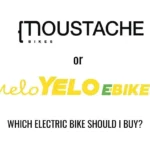There’s a lot of misinformation out there about mid drive vs rear hub drive motors. So, let’s tackle this issue.
The primary customers for MeloYelo ebikes are seniors – older people who intend to use their electric bike for riding urban cycleways, rail trails, and wine trails, for example. For these intended uses, electric bikes with a rear hub motors are completely adequate, are less expensive than a mid-drive ebike, and come fitted with a thumb throttle that can deliver motor power to the wheels from a standstill, which some riders find a very helpful aid.
If you intend to use your electric bikes for trail rides that include steeper hills and the requirement on some off-road trail sections to cover 60 or 70 kilometres in a day, then a mid-drive motor will be a better choice.
Why are Hub Drive Motors Less Expensive than Mid Drive Motors?
Hub drive motors have been around longer and have been produced in larger volumes than mid drives, so the manufacturing cost per unit is less. Another reason is that producing a frame to incorporate a mid-drive motor is more expensive than producing a frame suitable for a rear hub motor.
Mid Drive Motors Are More Efficient Than Hub Drive Motors in Certain Situations
Mid drive motors can use the energy in your battery more efficiently in certain situations, particularly hill climbing on backcountry trails. This difference highlights the hub motor vs mid drive performance gap, on a demanding trail ride, a 500 watt-hour battery on a mid-drive might deliver the same range as a 550 or 600 watt-hour battery on a hub drive.
The Gear Ratio on a Mid-drive Motor is Superior to Hub Drive Motors
The single largest advantage that mid-motors have over hub motors is their gear ratio. They allow the rider to power the rear wheel via the same chain and gear set as the pedals, which means that a low gear can be selected for powering up steep hills or accelerating from a stop with massive torque. A mid-drive motor in low gear can climb steeper hills than a hub motor of similar power and can climb hills for longer than a hub motor. A mid-drive motor is also usually smaller and lighter than a hub motor of similar power.
A Quick Comparison
| Mid-Drive | Hub-Drive | |
| Cost | More expensive | Less expensive |
| Torque (turning force) | More torque | Less torque |
| Throttle assist from 0km/hr | In some cases | Yes |
| Efficiency in flat to moderately hilly conditions | Equal | Equal |
| Efficiency in steeper off-road conditions | More efficient | Less efficient |
Are Some Electric Bike Motor Brands More Reputable Than Others?
Yes. The most reputable brands of motors in ebikes in NZ are Bosch, Brose, Shimano, Yamaha, and Bafang. These are the brands that were reviewed by Consumer Reports NZ. You can read their review here.
What Does Torque Mean, and Why Does It Matter?
Torque is a measure of the motor’s turning force. The more torque, the more turning force the motor has. Some ebikes have as little as 40 newton-metres of torque, while others have 80 newton-metres or even more. The primary situation where more torque will make a big difference is when you’re riding steep, windy off-road trails.
A Final Note about Hub Drive Motors
Most bike shops do not carry ebikes fitted with hub drive motors. There are a couple of key reasons for this:
- Historically, their customers have been younger cyclists who are more apt to want to tackle steeper, off-road cycling adventures;
- There’s not as much profit to be made with a hub drive bike, because they are less expensive.
However, don’t let this discourage you from considering an e-bike with a hub drive motor. MeloYelo’s Town’nTrail has a hub drive motor with a thumb throttle (some call it the turbo button) which delivers motor power to your wheels without you having to pedal. This can be extremely beneficial for riders who want to get moving again from a standstill, or for those who want an extra burst of motor assistance while climbing a steep hill. And, at under $3500, the Town’nTrail is one of the most affordable trail bikes on the market.
Conclusion
There are some performance and efficiency differences in certain situations, and if you expect to find yourself in off-road situations that involve long, steep hill climbs, then a mid motor ebikes may be the answer for you. For the city rider or the recreational trail rider (urban cycleways, rail trails, etc.), a hub motor will do just fine.
FAQs
Which motor is best for steep hills?
A mid-drive motor is better for steep hills because it delivers more torque (turning force).
Are hub-drive motors good for seniors?
Yes, hub-drive motors can be a great choice for seniors, depending on the kind of riding they will be doing. For those whose riding is mostly either around town or on light to moderate off-road trails, a bike with a hub-drive motor is a great choice and will be less expensive than a bike with a mid-drive motor.
What’s the best motor for city riding?
For riding around town, a hub-drive motor is all you need.
Can a hub-drive motor handle off-road trails?
Yes. Thousands of MeloYelo customers use their hub-drive Town’nTrail model ebikes for riding off-road trails and are very satisfied with their bikes. You can read their reviews here. Note, however, that for steeper off-road trails, a mid-drive motor will give you more climbing assistance and more efficient use of the battery.
Is a mid-drive worth the extra cost?
If you think you’re going to be tackling a lot of longer, grade 3 trails, then yes. If you’re mostly going to be riding around town, or on rail trails, wine trails, etc., then perhaps not.












